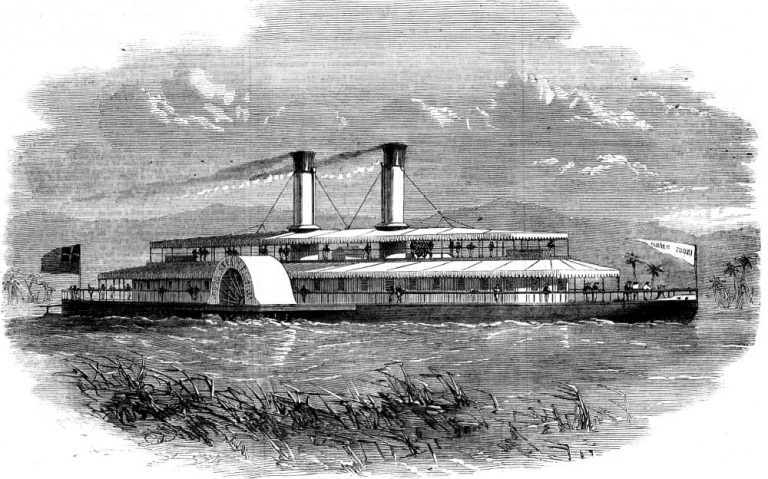
In 1839, the town of Karachi was captured and a flotilla of warships of the Bombay Marine was stationed there. This military Indus Flotilla remained until it was disbanded in 1861. Its base was the small town of Kotri.
Tim Willasey-Wilsey
The Indus, one of the great rivers of the world, flows from the Himalayan Mountains in Tibet and emerges into the Arabian Sea near the port city of Karachi almost 2000 miles from its source. On its journey south it is joined by a number of major rivers; the Kabul River merges at Attock and just north of Mithan Kot it combines with the 5 rivers of the Punjab (the Ravi, Beas, Chenab, Sutlej and Jhelum). A considerable proportion of Pakistanis and Indians rely on the Indus and its tributaries for their drinking water and for irrigation of their crops.
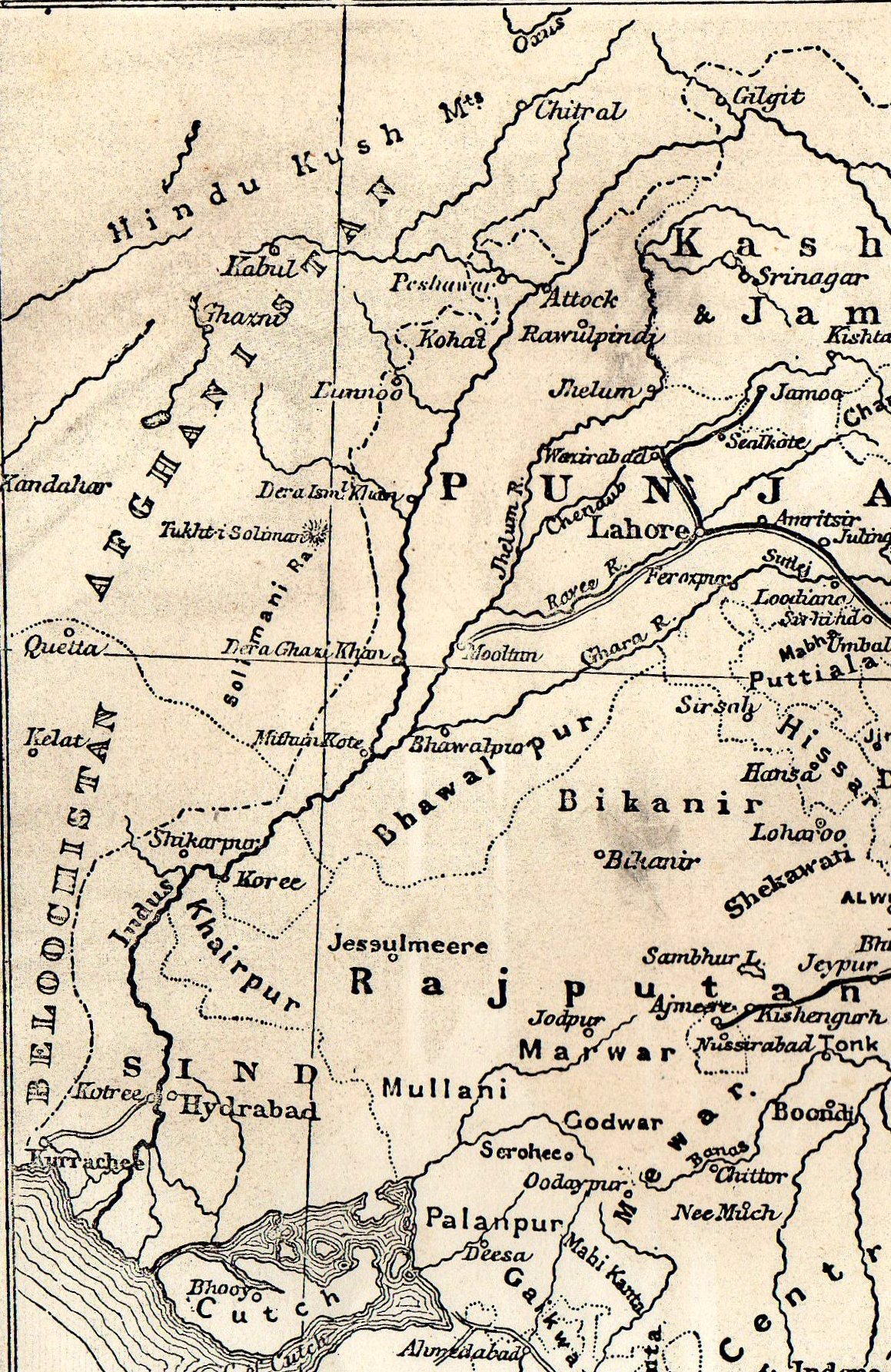
The British East India Company started showing interest in the Indus in the early 1830s.In 1835 Lieutenant John Wood sailed a small steamer, the Indus, up the river. In 1839, at the same time as the ill-fated expedition to Afghanistan, the town of Karachi was captured and a flotilla of warships of the Bombay Marine was stationed there. This military Indus Flotilla would remain until it was disbanded in 1861. Its base would be the small town of Kotri (which is on the opposite bank to Hyderabad, the former capital of Sindh).
Those early steamers were the Planet and the Satellite of 350 tons. Mrs. Postans, the adventurous wife of a British officer, has left us with a wonderful account of the discomfort of a trip down the Indus from Sukkur to Karachi at the height of the hot weather:
On the 26th of May [1841], we were on board the Planet steamer, lying off the Sukkur agency, in a part of the Indus which perhaps commands one of the liveliest panoramic views upon its banks… The smooth, clean deck of the steamer offered an agreeable contrast to the dirt and misery which would be endured on board the strange, heavy-looking native craft, where, we well knew, mosquitoes and spiders were especially at home, and whole tribes of rats waited but the close of day to make “night hideous” with their orgies… The Planet is the second fastest steamer on the river, the Satellite bearing away the bell. The former is of 75-horse power, and draws only about two feet and a half of water, her crew principally composed of fine, fresh-complexioned Englishmen. The heat of the first day was almost unbearable, and at four o’clock, when we all dived into a cuddy, about four feet by ten, to partake of roast fowls, curry, and pale ale, notwithstanding the wind sail and the miniature punkah [fan], it was a gasping scene…On the first day, we met the little Satellite steaming up with every appearance of being determined to do a very difficult thing in the best possible manner. [147-153]
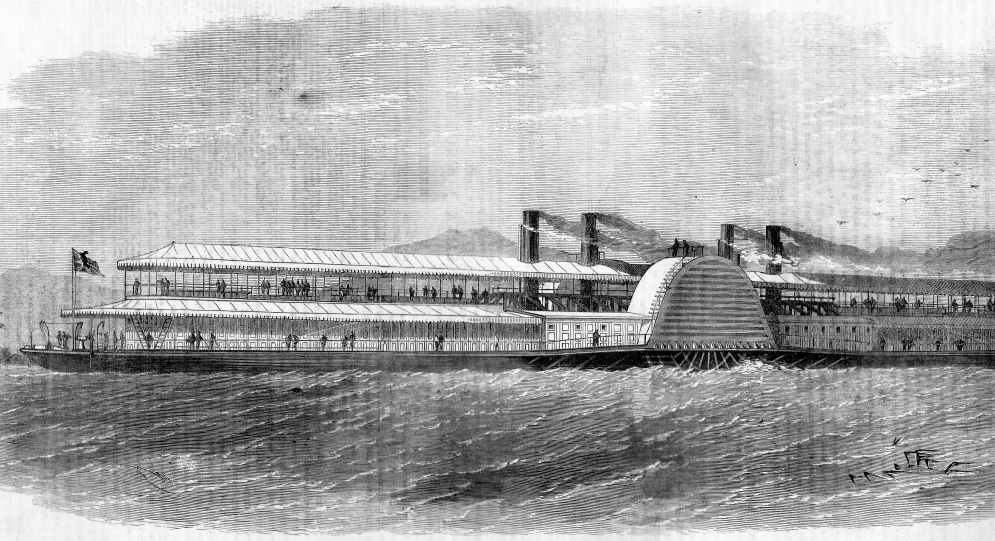
When General Sir Charles Napier captured the remainder of Sindh in 1843 the river steamers were able to play a helpful role; carrying troops, shelling the enemy on the banks and preventing them from crossing the river. Whilst the Planet and Satellite played the major parts they were joined by the Napier and Meteor, Comet and Meanee, Conqueror, Satellite, Assyria and Nimrod. So helpful were they to his campaign that Napier granted their officers and crews the Sindh medal and allowed them a share of the war booty.
When General Sir Charles Napier captured the remainder of Sindh in 1843 the river steamers were able to play a helpful role; carrying troops, shelling the enemy on the banks and preventing them from crossing the river.
All of these early steamers were made of iron and were armed with 2 guns. They were mostly around 200 tons and developed 40 to 60 nominal horsepower (nhp). Most were built by Cammell Laird in their yard at Wallasey near Liverpool and shipped out in parts for reassembly in Bombay. In 1851 three bigger Cammell Laird steamers were assembled at Bombay. These were 500 ton vessels; the Indus, Jhelum, and Chenab. In 1857 Bombay assembled four more and they were bigger still at 610 tons and with 120nhp engines; the Frere, Havelock, Outram, and Sir Henry Lawrence. These were the last Indus steamers made by Cammell Laird which moved to Birkenhead in the same year.
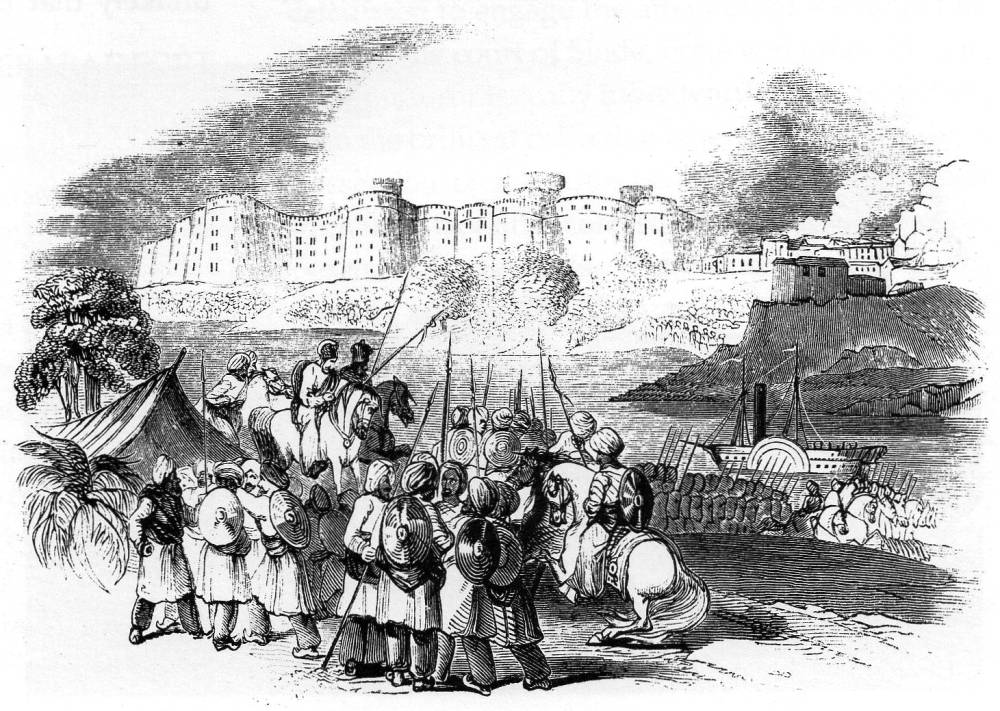
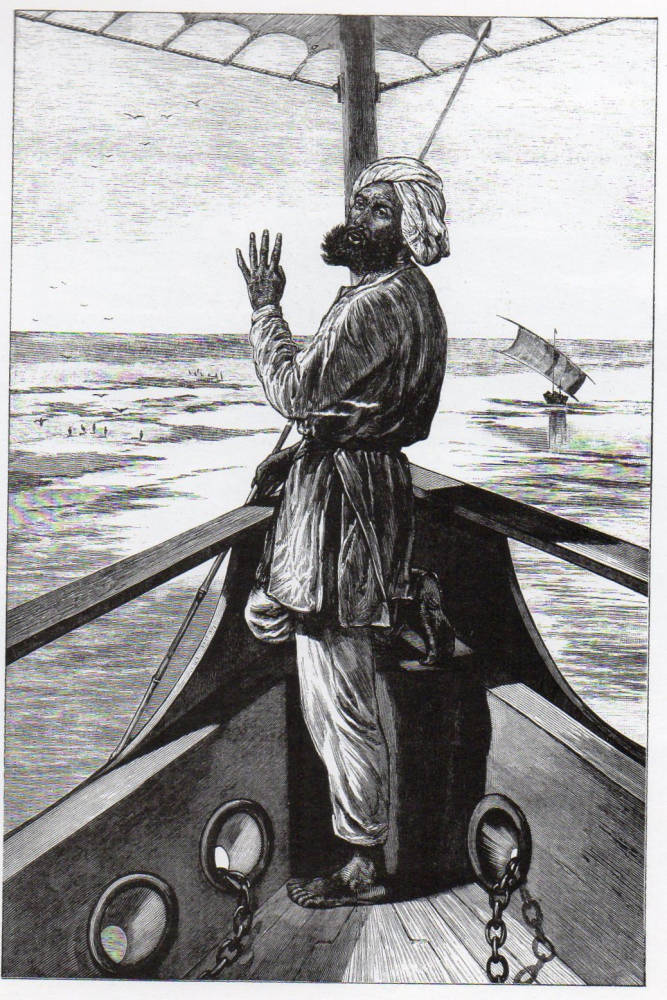
This was the high point of enthusiasm for the Indus Flotilla, but making the Indus navigable became a constant headache. The river is relatively manageable from Kalabagh in the north to Hyderabad but south of Hyderabad towards Karachi it enters a wide and flat delta. As Charles Rathbone Low observes, “The Indus has no less than thirteen or fourteen mouths. The main river, after passing Hyderabad and Thatta, divides about fifty miles from the sea into two great arms… Between Manora Point and Hujamree the coast is low and intersected by numerous channels and creeks” (p 100). There was a constant risk of running aground, and the channels were always changing. In 1841 the Planet carrying Mrs. Postans stopped at Thatta. She had to transfer to a small local craft for the grueling journey through the Indus delta to Karachi.
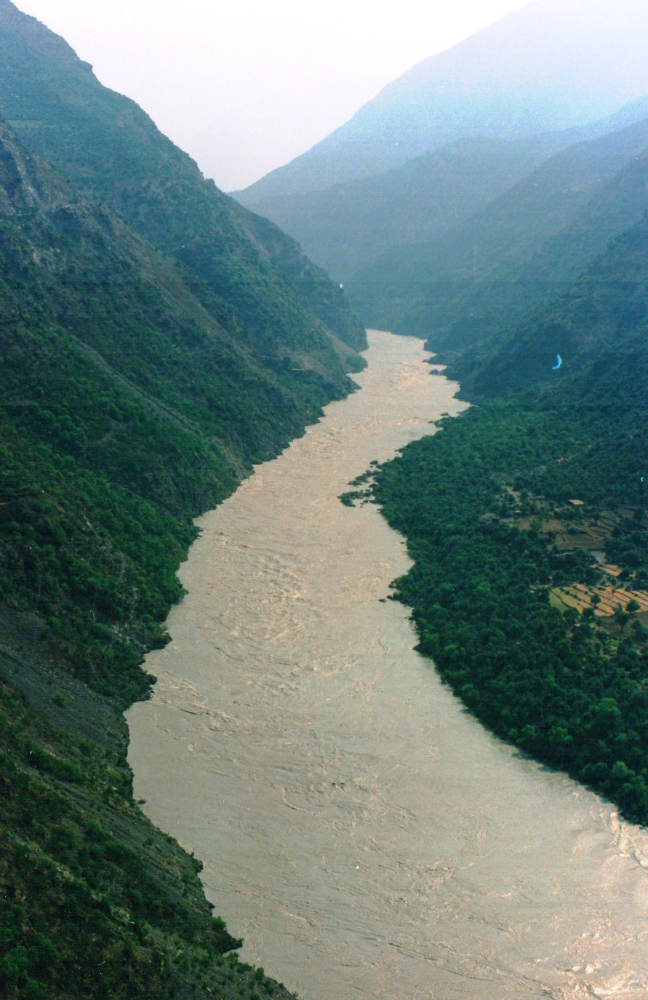
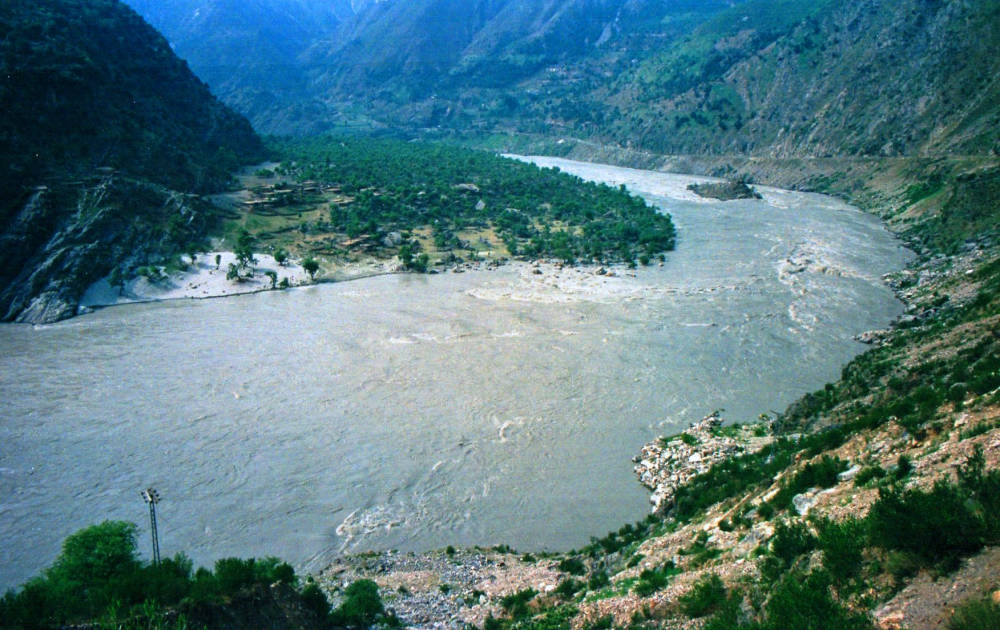
Indeed the observant Mrs. Postans pointed to two more difficulties. “We remarked how the steamer cast down great masses of the banks as she made her rapid course; now a large tree would fall in with a crash, and then a towering pile of wood, placed inadvertently too near the bank. The result of this agitation of the stream, with the undermining effect of the inundations, is a perpetual change in the channel of the water.” Also fuel was a major problem “This fuel is purchased from the cutters, who are allowed tracts of wood lands …The bulk of the fuel is a serious objection to its use, for every evening the necessary consumption for the following day is taken in.”
Yet in spite of these drawbacks W. P Andrew (later Sir William Andrew), a vociferous advocate of new transport routes, saw its advantages in strikingly strategic terms; “Holding as we do the Indus from Kashmir to the sea we have a power which if well understood and wisely improved puts us in possession of the key to the whole commerce of Central Asia which cannot be pursued without adding to the prosperity and productiveness of our new territories (Sindh and the Punjab)” (p 87).
In 1855 it was decided to found the Sindh (Scinde) Railway to connect Karachi to Hyderabad. There followed a frenetic debate between those who believed that there was still a role for the steamers and those who favored a railway connecting the Punjab to Sindh. This argument was still in full flow when the Great Mutiny of 1857 broke out. Fortunately for the British, Bartle Frere the Chief Commissioner of Sindh had just arrived back from leave in England. Believing Sindh to be safe from an outbreak of mutiny, he sent all available troops up-river to the Punjab where Company troops were in desperate straits. Martineau, his biographer, records that “it was a grievous disappointment and annoyance to Frere, on his return to Sindh, to find that the Indus flotilla, on the importance and efficient maintenance of which he had so repeatedly and emphatically insisted, was now, in the hour of trial, not immediately or fully available.” Several steamers were supporting troops in Persia whilst some new vessels shipped out in parts from England were being laboriously reassembled in Bombay (modern Mumbai). These must have been the four 610 ton steamers mentioned earlier.
But Frere was lucky with the river conditions. “The two first steamers with two hundred men under Captain Dansey passed the Sukkur Rapids in safety on the l0th. This was a great load off my mind, for ….it was quite possible they might have found the Rapids at Sukkur impassable; but the river fortunately fell suddenly for two or three days, and by great exertion the steamers were warped through. I hope they will be at Multan by the 17th” (Martineau p 185).
But river transport could not cope with the large quantities of stores needed by the army in the Punjab. “Of English rifle-bullets alone there were forty-five tons awaiting transmission, and about thirty-five tons of other stores ; while in the Punjab, hospital supplies and clothing were greatly needed, and such was the scarcity of ammunition there that the conduct and success of the siege of Delhi was being seriously endangered by it”. Instead Frere had to arrange camel convoys across the desert. As The Lahore Chronicle in 1857 observed, “What a glorious thing it would have been, had the Sindh and Punjab Railway been accomplished facts at the time of the present insurrection. How it would have astonished the natives to have seen a gallant British Army landed at Lahore within a month of the outbreak taking place.”
Brunton, who was the Engineer in charge of the steam flotilla, received Scott Russell’s steamer, which he calls the Pioneer, in Karachi in sections. He assembled and launched it on the Indus at Kiamari near Karachi.
The argument for a purely commercial river service continued. William Andrew stipulated to Sir James Melvill, (Secretary of the East India Company) in a letter dated 20th April 1857 that “I should prefer a vessel combining various points of construction advocated … in Mr. Yarrow’s report, which would secure ample accommodation for passengers and merchandise drawing two feet of water and of sufficient power to give an effective speed of 10 miles an hour against the current of the Indus.” (p 90). Alfred Yarrow, a London shipbuilder who would later found the famous Yarrow shipyards in Glasgow.
The requirement for a more effective Indus craft led to a competition in England to design the ideal vessel. The first was built by John Scott Russell for the Indus Steam Flotilla, part of the Sindh and Punjab Railway Company. It had to be 200 feet long, 38 wide and have a draft of only 2 feet. It had to be capable of 12 mph, of carrying a load of 350 tons of cargo and passengers and of towing barges of 500 tons. Scott Russell built the vessel at the former Millwall Ironworks on the Thames where he was also building Brunel’s gigantic Great Eastern.
A second experimental vessel was shown in the Illustrated London News in February 1861. This was designed by T.B. Winter and built by M. Pearse and Co of Stockton-on-Tees. She was a monster with 4 funnels, 377 feet in length, 74 beam and 5 feet in depth but only 2 feet draft, 739 tons and 220 nominal horse power. She had room for 800 troops with an ingenious method of cooling their accommodation and managed 12 mph during her trials on the Thames. She appears to have been later named Talpore. She was the largest river steamer of her time, hardly an advantage given the difficult conditions of the Indus.
Another insight is provided by John Brunton’s wonderful memoir for his grandchildren. Brunton, who was the Engineer in charge of the steam flotilla, received Scott Russell’s steamer, which he calls the Pioneer, in Karachi in sections. He assembled and launched it on the Indus at Kiamari near Karachi. Then, with his wife, he boarded the vessel at Kotri for a journey to Multan, 700 miles up-river. It took an agonizing 34 days. Brunton records that “I amused myself with my rifle shooting at crocodiles and alligators” (p. 108). Although the return journey to Kotri took only seven days, Brunton observed “I had to make considerable alterations in the vessel before I could put her on regular voyages. She never was a success. Other steamers built by Richardson and Duck followed her and were far better as to speed and accommodation.” Scott Russell’s Pioneer may be the vessel shown in the plate of Sir William Mansfield’s arrival at Sukkur in about 1866.
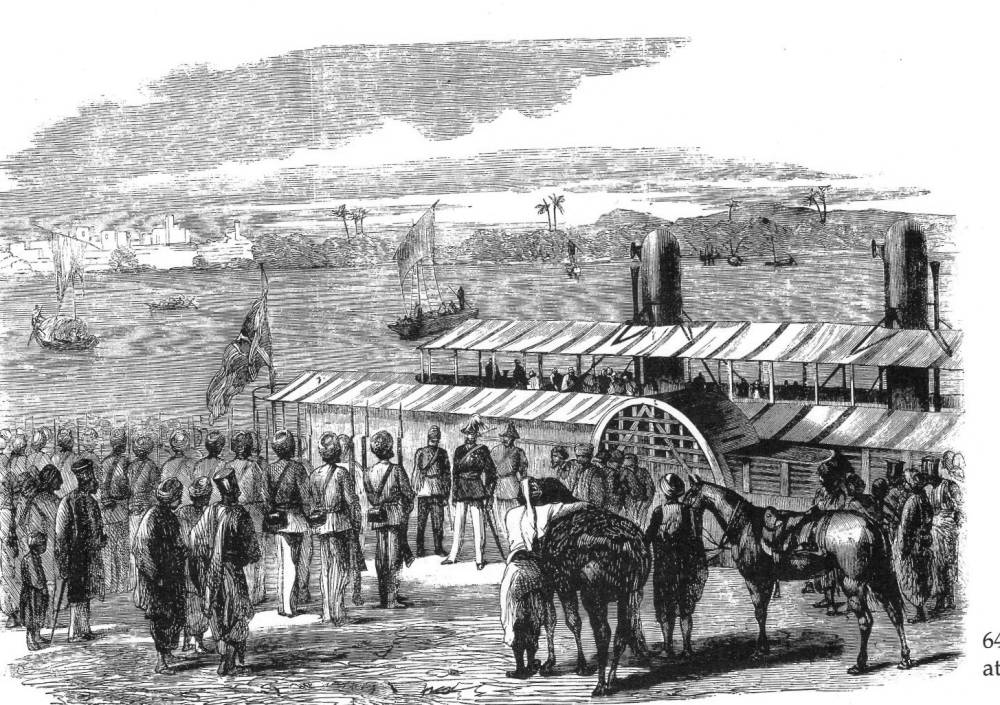
The website which lists Richardson, Duck, and Company ships shows that they made no fewer than six paddle steamers, seven barges and a crane barge in 1859 for shipment to the Indus. The paddle steamers were 200 feet long by 38 beam. The engines were built by Hewitson, Kitson and Thompson of Leeds and developed 140 nhp. They were consigned to the Oriental Steam Navigation Company and were reassembled in-country in 1861. The company had been formed in 1858 under the same John Wood, now a Captain and famous as the man who discovered the source of the Oxus, but it failed in 1861 and was superseded by the commercial “Indus Steam Flotilla” (not to be confused with the military “Indus Flotilla”.
After the suppression of the Mutiny the British Government took control in India from the East India Company. In 1858 it was also decided to reduce the Indus Flotilla from 15 steamers to only 6 and the number of barges (known as “flats”) from 10 to 6. Three years later the flotilla was disbanded completely along with the Bombay Marine (often known as the Indian Navy). According to Low, the “Indus Steam Flotilla and Punjab Railway Company” took over certain of the Government steamers and flats and in August, 1861, the last remnant of the Flotilla ceased to exist.
In 1859 the first section of the railway from Karachi to Hyderabad was opened and the line was finally opened on 13th May 1861 It was a remarkable achievement. No fewer than 32 bridges were built over a 16 month period. But at Kotri all the passengers and cargo had to transfer to Indus steamers. It did not take long for critics to point to the lack of commercial viability of this process compared to a railway which could go straight through to Multan, Lahore, Amritsar, and Delhi. In 1878 Lahore was connected to Karachi by railway although until 1889, when the Lansdowne bridge was completed over the Indus at Sukkur, travelers from Karachi coming up to the west bank of the river by train had to be ferried over to take another train on the east bank. While the railway and bridge were being built steamships from the flotilla stood by to fill the gaps (Fairley p 244).
By the 1880s, the steamers were just performing odd jobs and by 1889 they were mostly redundant. The 1908 Imperial Gazetteer wrote “As a channel of navigation the Indus has disappointed the expectations that were at one time formed”. However Major Chesney had attested to Parliament as early as 1834 that “It is now, however, pretty certain that the Euphrates is not a river for steaming, and the hopes entertained with regard to the Indus are far less sanguine than they were two years ago”.
A few vestiges remained. One Indus Steam Flotilla boat was photographed at Kotri in 1927.. Three newer paddle steamers were used as ferries as late as the 1990s. The failure of the Indus Flotilla was partly a result of adverse river conditions but also due to the cost of transferring freight from river to railway. In contrast, the hugely successful Irrawaddy Flotilla in Burma had to contend with equally difficult river conditions, but all the key trading hubs in Burma (Bhamo, Mandalay and Rangoon) were accessible on one river journey.
______________________
Tim Willasey-Wilsey was Senior Visiting Research Fellow at the Centre for Defence Studies, King’s College, London (2014)
Courtesy: The Victorian Web